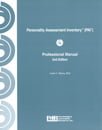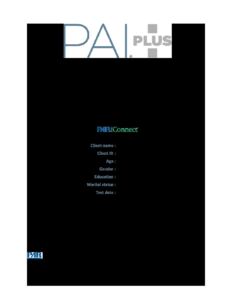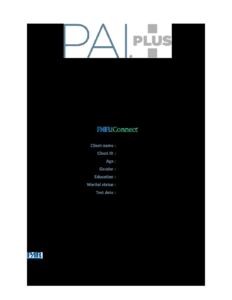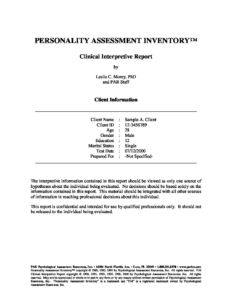
Personality Assessment Inventory [PAI-PAI-PLUS]
Assessment of adult psychopathology in ages 18 years and older
For Ages: Adult
Administration Time: 50-60 minutes
Format & Scoring: Online administration and scoring via PARiConnect; Software scored and Hand scored
Author: Leslie C. Morey, PhD
Manuals available in hard copy (book) or electronic version (e-Manual)
PAI Plus is an updated way to interpret PAI data
PAI Plus Software update available here
Online Forms, Reports, Kits & e-Manuals
All online resources including Forms, Reports, i-Admins, Kits and e-Manuals.
Printed Manuals
Physical printed manuals.
Printed Forms & Handscoring Materials
Test forms, response booklets and scoring reference manuals.
Printed Kits
Click to browse products
Books & Workbooks
Click to browse products
PAI Plus e-Manual Supplement
PAI e-Manual
PAI online Public Safety Selection Report (each) min order 5
PAI online i-Admin (each) min order 5
PAI/PAI Plus online Interpretive Report (each) min order 5
PAI/PAI Plus online Score Report (each) min order 5
PAI Audio Administration – CD ROM
PAI Casebook for the PAI: A Structural Summary Approach, Hardcover
PAI Interpretive Guide to the PAI, Hardcover
PAI Plus Manual Supplement
PAI Professional Manual, 2nd Edition
PAI Adult Profile Forms (25) – Revised
PAI Critical Items Forms (25) – Revised
PAI Form Hand Scorable Answer Sheets (25)
PAI Hardcover Reusable Item Booklet
PAI Softcover Reusable Item Booklets (10)
PAI Structural Summary Forms – Revised (25)
PAI Casebook and Interpretive Guide Kit
PAI Comprehensive Kit
PAI Administration Folio
PAI Plus update
The PAI Plus takes the existing PAI items and gives users an updated way to interpret the data. Using the PAI, an objective inventory of adult personality, the new report offers:
- DSM-5® update: Updated diagnostic possibilities align with the criteria.
- Alternative Model Profile: An optional new profile scores in accordance with the Alternative Model for Personality Disorders.
- Additional supplemental indices: Based on years of academic research, 15 new supplemental indices provide additional profile information related to negative and positive distortion and random responding. Supplemental clinical indicators provide profile information related to suicidality, aggression, level of care, presence of ADHD, and more.
- Context-specific norm groups: Including profile overlays for bariatric surgery candidates, child custody evaluations, chronic pain patients, college students, deployed military, egg donors/gestational carriers, motor vehicle accident claimants, police applicants, and potential kidney donors. This profile is overlayed onto the examinee’s profile to allow for comparison.
- Updated report: An updated look and feel create a streamlined and modern-looking report.
A manual supplement details the research, theory, and development behind this update. The PAI Plus Manual Supplement only covers additions found in this version of the report. Purchase of the PAI Professional Manual, 2nd Ed. is recommended.
Online administration in PARiConnect Online account
Leading the way in online assessment. In January 2013, PAR launched their new online assessment platform called PARiConnect. For over ten years, it is one of the most popular platform in the online assessment industry. Updated with features customers asked for, adding trustworthy instruments, PARiConnect remains in-demand-feature in the decades to come.
Why use the PAI Plus online?
- Flexible administration options
- Powerful report options
- Client-centric design
- Reliable verification tools
- Easy and affordable purchase options via PAA website above
- Adaptability for any type of organisation
- Strict data security
- Simple technical requirements
- Enterprise manager
The PAI continues to raise the standard for the assessment of adult psychopathology. This objective inventory of adult personality assesses psychopathological syndromes and provides information relevant for clinical diagnosis, treatment planning, and screening for psychopathology. Since its introduction, the PAI has been heralded as one of the most important innovations in the field of clinical assessment.
PAI Scales and Sub-scales
The 344 PAI items constitute 22 non-overlapping scales covering the constructs most relevant to a broad-based assessment of mental disorders: 4 validity scales, 11 clinical scales, 5 treatment scales, and 2 interpersonal scales. To facilitate interpretation and to cover the full range of complex clinical constructs, 10 scales contain conceptually derived sub-scales.
The PAI Clinical scales were developed to provide information about critical diagnostic features of 11 important clinical constructs. These 11 scales may be divided into three broad classes of disorders: those within the neurotic spectrum, those within the psychotic spectrum, and those associated with behaviour disorder or impulse control problems.
The Treatment scales were developed to provide indicators of potential complications in treatment that would not necessarily be apparent from diagnostic information. These five scales include two indicators of potential for harm to self or others, two measures of the respondent’s environmental circumstances and one indicator of the respondent’s motivation for treatment.
The Interpersonal scales were developed to provide an assessment of the respondent’s interpersonal style along two dimensions: a warmly affiliative versus a cold rejecting style and a dominating/controlling versus a meekly submissive style. These axes provide a useful way of conceptualising many different mental disorders: persons at the extremes of these dimensions may present with a variety of disorders. A number of studies provide evidence that diagnostic groups differ on these dimensions.
The PAI includes a Borderline Features scale and an Antisocial Features scale. Both of these scales specifically assess character pathology. The Borderline Features scale is the only PAI scale that has four sub-scales, reflecting the factorial complexity of the construct. The Antisocial Features scale includes a total of three facets: one assessing antisocial behaviours, and the other two assessing antisocial traits.
No Scoring Keys Needed
Clients with 4th-grade reading skills may usually complete the PAI in less than 1 hour, rating each of the 344 items on a 4-point scale ranging from False, Not at all true, to Very true. Responses are entered on a 2-part carbonless Answer Sheet. The bottom page of the Answer Sheet provides scores for all 344 items. Scales and subscales may be hand scored in only 15-20 minutes.
For situations where no desk or table top is available, the handy PAI Administration Folio holds both the Item Booklet and Answer Sheet and provides a hard surface so your clients may easily complete the inventory.
The PAI Software Portfolio provides comprehensive, useful and accurate 10-15 page PAI Clinical Interpretive Reports or 2-4 page PAS Score Reports.
Interpreting PAI Test Results
To provide interpretation relative to the standardisation sample of 1,000 community-dwelling adults, PAI scale and subscale raw scores are translated to T scores. Transformed T scores have a mean of 50 and a standard deviation of 10, so that T-score values greater than 50 are above the mean in comparison to scores of individuals in the standardisation sample. Therefore, T scores greater than or equal to 70 (2 standard deviations above the mean) will quickly alert you to a pronounced deviation from typical responses of adults in the normative sample.
The Profile Form Adults-Revised allows you to rapidly translate raw scores to T scores and plot the pattern of test results and it also contains a blue line demarcating the distribution of scores for a large sample of clinical cases. This feature facilitates comparison of an individual’s scores with those in the clinical sample.
Critical Items
The Critical Items Form-Revised lists 27 items (distributed across nine content areas) that suggest behaviour or psychopathology that may demand immediate attention. They are identified as critical based on two criteria: indications of a potential crisis situation and a very low endorsement rate in normal individuals.
Reliability and Validity
Reliability and validity are based on data from a U.S. census-matched normative sample of 1,000 community-dwelling adults (matched on the basis of gender, race and age), a sample of 1,265 patients from 69 clinical sites, and a college sample of 1,051 students.
Because the PAI was normed on adults in a variety of clinical and community settings, profiles may be compared with both normal and clinical populations. Combined-gender normative data are provided. Reliability studies indicate that the PAI has a high degree of internal consistency across samples – results are stable over periods of 2-4 weeks (median a and test-retest correlations exceed .80 for the 22 scales). Validity studies demonstrate convergent and discriminant validity with more than 50 other measures of psychopathology.
PAA Scoring Bureau Services
Psychological Assessments Australia (PAA) provide a Report Scoring Bureau Service for practitioners.
Our scoring bureau fee is charged per report, in addition to the cost of the report requested.
We offer two levels of Scoring Bureau Services:
- Standard Service – reports will be scored and returned within a 24-hour turnaround period from receipt. We will use this level of service unless a rush service is requested.
- Rush Service – reports will be scored and returned within a 2-hour turnaround period from receipt.
Simply email or fax your client’s completed assessment answer sheet to PAA for scoring. Nominate the type of report you would like generated from the range of reports available. Your report will be scored and returned to you by email or fax. You will be charged for the cost of the report, plus the nominated Scoring Bureau Fee (per report).
Download and Print the PAA Email / Fax Order Form for your convenience.
Or Download and Print the New Zealand PAA Email / Fax Order Form for ex-GST prices.
Sample Reports






